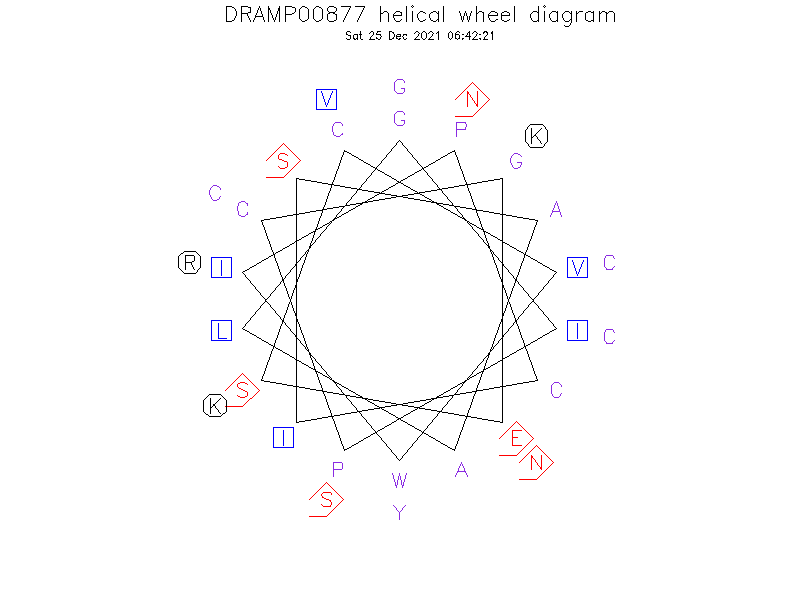General Information
-
DRAMP ID
- DRAMP00877
-
Peptide Name
- Circulin-A (CIRA; Plant defensin)
-
Source
- Chassalia parviflora
-
Family
- Belongs to the cyclotide family
-
Gene
- Not found
-
Sequence
- GIPCGESCVWIPCISAALGCSCKNKVCYRN
-
Sequence Length
- 30
-
UniProt Entry
- P56871
-
Protein Existence
- Protein level
Activity Information
-
Biological Activity
- Antimicrobial, Antibacterial, Anti-Gram+, Anti-Gram-, Antiviral, Antifungal
-
Target Organism
-
- [Ref.10430870]Gram-positive bacterium: Staphylococcus aureus (MIC=0.19 µM).
- Gram-negative bacterium: Proteus vulgaris (MIC=54.6 µM).
- Fungi: Candida kefyr (MIC=18.6 µM) and Candida tropicalis (MIC=19.4 µM).
- NOTE: Medium with 10 mM phosphate buffer.
- [Ref.18008336]Virus:HIV:inhibition the cytopathic effects of HIV-1 infection in cultured human T-lymphoblast (CEM-SS) cells(EC50=40-260 nM).
-
Hemolytic Activity
-
- [Ref.10430870] EC50 = 1020 μM against blood type A human erythrocytes.
-
Cytotoxicity
-
- [Ref.18008336]CEM-SS cells:IC50=500 nM.
-
Binding Target
- Not found
Structure Information
-
Linear/Cyclic
- Cyclic
-
N-terminal Modification
- Cyclization (N termini to C termini)
-
C-terminal Modification
- Cyclization (C termini to N termini)
-
Nonterminal Modifications and Unusual Amino Acids
- [Ref.8920961] There are three disulfide bonds between Cys4 and Cys20, Cys8 and Cys22, Cys13 and Cys27
-
Stereochemistry
- L
-
Structure
- Alpha helix (1 helices; 4 residues)
-
Structure Description
- The molecule is stabilised by three disulfide bonds, two of which form an embedded loop completed by the backbone fragments connecting the cysteine residues. A third disulfide bond threads through the centre of this loop to form a "cystine-knot" motif. This motif is present in a range of other biologically active proteins, including omega-contoxin GVIA and Cucurbita maxima trypsin inhibitor.
-
Helical Wheel Diagram
-
PDB ID
- 1BH4 resolved by NMR.
-
Predicted Structure
- There is no predicted structure for DRAMP00877.
Physicochemical Information
-
Formula
- C134H216N38O39S6
Absent Amino Acids
- DFHMQT
Common Amino Acids
- C
Mass
- 3175.78
PI
- 8.33
Basic Residues
- 3
Acidic Residues
- 1
Hydrophobic Residues
- 9
Net Charge
- +2
-
Boman Index
- -12.24
Hydrophobicity
- 0.417
Aliphatic Index
- 78
Half Life
-
- Mammalian:30 hour
- Yeast:>20 hour
- E.coli:>10 hour
Extinction Coefficient Cystines
- 7365
Absorbance 280nm
- 253.97
Polar Residues
- 15
DRAMP00877

Comments Information
Function
- Probably participates in a plant defense mechanism. Has antibiotic activity. Inhibits the cytopathic effects and replication of the human immunodeficiency virus. Relatively ineffective against Gram-negative bacteria such as E. coli and P. aeruginosa.
PTM
- This is a cyclic peptide which contains three disulfide bonds 1-17; 5-19; 10-24.
Literature Information
- ·Literature 1
-
Title
- Cyclotides as natural anti-HIV agents.
-
Pubmed ID
- 18008336
-
Reference
- Biopolymers. 2008;90(1):51-60. doi: 10.1002/bip.20886.
-
Author
- Ireland DC, Wang CK, Wilson JA, Gustafson KR, Craik DJ.
- ·Literature 2
-
Title
- An unusual structural motif of antimicrobial peptides containing end-to-end macrocycle and cystine-knot disulfides.
-
Pubmed ID
- 10430870
-
Reference
- Proc Natl Acad Sci U S A. 1999 Aug 3;96(16):8913-8918.
-
Author
- Tam JP, Lu YA, Yang JL, Chiu KW.
- ·Literature 3
-
Title
- Solution structure by NMR of circulin A: a macrocyclic knotted peptide having anti-HIV activity.
-
Pubmed ID
- 9878410
-
Reference
- J. Mol. Biol. 1999; 285:333-345.
-
Author
- Daly NL, Koltay A, Gustafson KR, Boyd MR, Casas-Finet JR, Craik DJ.
- ·Literature 4
-
Title
- Analysis of the disulfide linkage pattern in circulin A and B, HIV-inhibitory macrocyclic peptides
-
Pubmed ID
- 8920961
-
Reference
- Biochem Biophys Res Commun. 1996 Nov 12;228(2):632-8.
-
Author
- R Derua 1, K R Gustafson, L K Pannell

